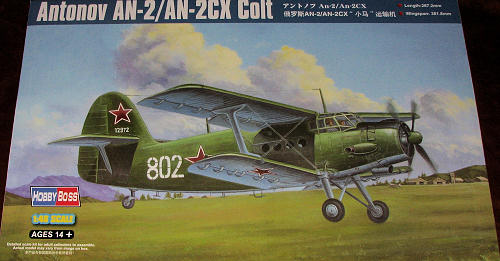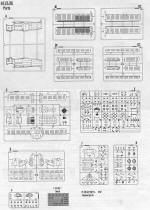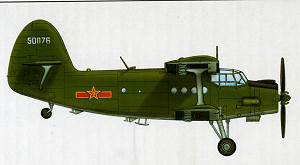
| KIT #: | 81705 |
| PRICE: | $68.99 SRP |
| DECALS: | Two options |
| REVIEWER: | Scott Van Aken |
| NOTES: | New tool kit |

| HISTORY |
The Antonov An-2 was designed to meet a 1947 Soviet requirement for a replacement for the Polikarpov Po-2 which was used in large numbers as both an agricultural aircraft and a utility aircraft. Antonov designed a large single bay biplane of all-metal construction, with an enclosed cockpit and a cabin with room for seats accommodating twelve passengers. The first prototype, designated SKh-1, and powered by a Shvetsov ASh-21 radial engine, flew on 31 August 1947. The second prototype was fitted with a more powerful Shvetsov ASh-62 engine, which allowed the aircraft's payload to be significantly increased from 1,300 kg (2,870 lb) to 2,140 kg (4,720 lb), and in this form it was ordered into production.
By 1960 the USSR had produced over 5,000 units. Since 1960, most An-2s have been built at Poland's WSK factory in Mielec, with over 13,000 made there before full production ended in 1991. Limited production from parts stocks, as well as spares and maintenance coverage continued until 2001, when 4 aircraft were produced for Vietnam. China also builds the An-2 under license as the Shijiazhuang Y-5.
The An-2 was designed as a utility aircraft for use in forestry and agriculture. However, the basic airframe is highly adaptable and numerous variants have been developed. These include hopper-equipped versions for crop-dusting, scientific versions for atmospheric sampling, water-bombers for fighting forest-fires, flying ambulances, float-equipped seaplane versions, lightly armed combat versions for dropping paratroops, and of course the most common An-2T version, which is the 12-seater passenger aircraft. All versions (other than the An-3) are powered by a 750 kW (1,000 hp) nine-cylinder Shvetsov ASh-62 radial engine, which was developed from the Wright R-1820.
The An-2 has design features which make it suitable for operation in remote areas with unsurfaced airstrips:
A note from the pilot's handbook reads: "If the engine quits in instrument conditions (blind flying when you can't see the ground) or at night, the pilot should pull the control column full aft (it won't stall) and keep the wings level. The leading-edge slats will snap out at about 64 km/h (40 mph), and when the airplane slows to a forward speed of about 40 km/h (25 mph), the airplane will sink at about a parachute descent rate until the aircraft hits the ground."
The An-2 indeed has no stall speed quoted in the operating handbook. Pilots of the An-2 say one can fly the aircraft in full control at 30 mph (as a contrast, a modern Cessna four-seater light aircraft has a stall speed of around 55 mph). This slow stall speed makes it possible for the aircraft to fly backwards (if the aircraft is pointed into a headwind of, say, 35 mph (56 km/h), it will travel backwards at 5 mph (8.0 km/h) whilst under full control). (This is also possible with almost any other true Short Take Off and Landing (STOL) aircraft, but the Antonov has the distinction of being able to do the trick in the mildest headwind).
| THE KIT |
 Adding to their new tool kits is this one on the Soviet workhorse of the early cold war, the An-2. This is not the first An-2 in this scale, as Valom did a series of short run kits of this aircraft. However, it is the first modern tooled mainstream injected An-2 in 1/48 scale.
Adding to their new tool kits is this one on the Soviet workhorse of the early cold war, the An-2. This is not the first An-2 in this scale, as Valom did a series of short run kits of this aircraft. However, it is the first modern tooled mainstream injected An-2 in 1/48 scale.
For those wondering, this will build into a very large model. If you have ever seen an An-2 in person, the first thing you realize is how large the aircraft actually is. I am not sure what the suffix CX means in the aircraft type, but I can tell you that this is not the scimitar bladed version.
Starting with the cockpit, you get a great deal of detail that includes separate throttle handles and a well detailed set of seats that fit to the aft cockpit bulkhead. There is also raised detail on the instrument panel and consoles. A decal is provided for the main instrument panel if you wish to use it. There is a separate forward cabin door that can be posed open if you wish. The cabin includes a roof and an optional set of jump seats alone either fuselage wall. The other option is to have them folded up. All of the cabin windows are installed from the inside.
The nicely detailed engine and cowling are separate items with the cowl in two halves. You can have the cowl flaps either open or closed. The kit comes with the tail section separate so that other versions can be accommodated using most of the same sprues. The wings have separate ailerons and flaps, but these seem designed to be attached in the neutral position. All of the little hinges are separate.
 The kit provides two different types of undercarriage. One is the standard wheeled undercarriage. The other is a set of skis. There is also a large 'gizmo' with a large intake that fits one the lower fuselage and is held proud of it by struts. I have no clue as to what this actually is.
The kit provides two different types of undercarriage. One is the standard wheeled undercarriage. The other is a set of skis. There is also a large 'gizmo' with a large intake that fits one the lower fuselage and is held proud of it by struts. I have no clue as to what this actually is.
Instructions are well drawn, and offer color information during the build. Not sure if interior green is the proper color for the inside, but that is what Hobby Boss recommends. Markings are for two unidentified units. Both aircraft are in green uppers with light blue undersides. One is the box art plane in Soviet markings and the other is in Chinese markings.
| CONCLUSIONS |
Nice to see this one being done in mainstream injected plastic. I know that there are a zillion different nations that used the aircraft and there are an equal number of interesting civil schemes. I doubt if this will be the last we see of a Hobby Boss An-2 as the molds are just right to do a number of other variants including the turboprop powered An-3.
| REFERENCES |
http://en.wikipedia.org/wiki/An-2
August 2012
My thanks to Squadron Products for sending in the preview kit. Get yours at your local shop or have them order it for you.
If you would like your product reviewed fairly and fairly quickly, please contact the editor or see other details in the